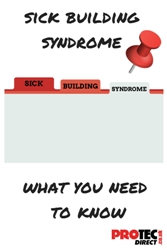Plagued by headaches? Coughs and colds seem to follow you around? Open plan offices make the dreaded “office lurgy” an ideal breeding ground but look closer and there could be a more serious underlying problem than meets the eye. Recognised by the HSE, Sick Building Syndrome is a recent phenomenon, causing employees to feel unwell in their place of work. Individuals experience symptoms of ill health that are linked to spending time in a particular building.
Although not a recognised illness, it can cause considerable distress to those who are experiencing symptoms, and cause increased absenteeism and reduced staff efficiency- problematic for business owners.
What are the symptoms?
Symptoms can vary greatly, but the most common symptoms include-
• Dry or itchy skin
• Dry or itchy eyes, nose or throat
• Headaches
• Poor concentration
• Tiredness
• Stuffy or runny nose
• Nausea
• Coughing or shortness of breath
Employees shouldn’t disregard symptoms or become confused with more severe illnesses directly linked with the workplace such as legionnaire’s disease, exposure to dangerous substances or long term hazards such as asbestos.
What are the risks and causes?
Although more research is required, the following have been highly linked to Sick Building Syndrome, and are high risk factors in aggravating symptoms.
• Poor ventilation
• Air conditioning
• Low humidity
• Poorly designed work stations
• Chemical and dust pollutants
• Frequent screen users
• Psychological factors- stress, or poor staff morale
Managing Sick Building Syndrome
If a number of employees are experiencing similar symptoms, it is important to investigate. An analysis of staff sickness and absence records will help highlight common issues, but speaking to your staff is the most important move to make.
If you think that your office building may be creating symptoms of sick building syndrome and would like further clarification, the Royal Society of Health has designed a questionnaire specifically for this purpose, allowing you to identify which parts of the building, groups of staff or time of day are proving particularly troublesome. The questionnaire is available from Health and Safety Executive area offices.
If problems persist, it may be worth discussing the issue with an expert in the field. Occupational health doctors can examine the employees experiencing the symptoms and identify if they have exposed to irritant or toxic substances.
Occupational hygienists, ergonomists and management specialists may also prove helpful, providing you with more conclusive answers and addressing some of the problem areas.
Interestingly, more women tend to report symptoms of sick building syndrome than men, but this may be linked to a greater number of women working in office related jobs.
Remember that employees should always be protected from irritant or toxic substances through the correct PPE equipment, but where causes aren’t so obvious it can be difficult to manage. For more information on sick building syndrome, visit the HSE.





Leave a comment